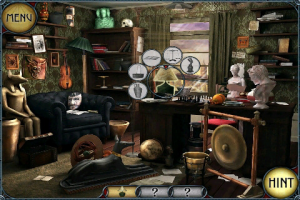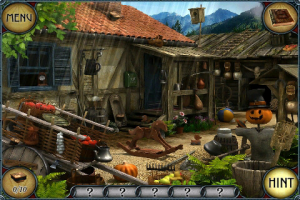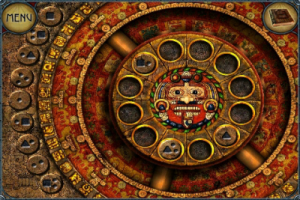An archaeologist has vanished shortly after announcing he was on the verge of an historic discovery. Naturally the only clues to his whereabouts lie in dozens of artifacts he had concealed around the globe before meeting his fate. Good thing his daughter, Nicole Rankwist, enjoys ferreting around for well camouflaged trinkets – and you had better share this scrupulous trait if you intend to join her quest. True to its “hidden object” label, Mystery of the Crystal Portal tests the player’s perception and visual acuity as he or she guides the protagonist’s search with touchscreen taps.
 In terms of technical execution Crystal Portal plays like a dream on the iPhone: the player can zoom in or out at will via simple pinching motions to get an optimal view of Nicole’s environment, and thanks to high definition graphics everything remains perfectly crisp. Each item collection is auto-saved on the fly, making this perfect for the casual gamer who wants something he or she can pick up or drop at a moment’s notice. User interface buttons detract from gameplay by obscuring needed items from time to time, but this is countered by the fact that one of those interface buttons offers clues at regular intervals should the player wish to call upon it.
In terms of technical execution Crystal Portal plays like a dream on the iPhone: the player can zoom in or out at will via simple pinching motions to get an optimal view of Nicole’s environment, and thanks to high definition graphics everything remains perfectly crisp. Each item collection is auto-saved on the fly, making this perfect for the casual gamer who wants something he or she can pick up or drop at a moment’s notice. User interface buttons detract from gameplay by obscuring needed items from time to time, but this is countered by the fact that one of those interface buttons offers clues at regular intervals should the player wish to call upon it.
Crystal Portal sticks close to genre conventions for the most part, so if the idea of scouring beautiful landscapes for list after list of hidden items doesn’t appeal to you, you won’t find much to get excited about here. Its plot is serviceable and satisfactorily delivered but falls victim to a lack of text revision, a few minor typos during the intro cutscene snowballing into very noticeable gaffes during Nicole’s later conversations. Given the player’s goal of clearing large “Key Objects” from Nicole’s environment in order to reveal the more important artifacts she’s after, collections typically operate on a bizarre logic. In one instance, for example, the player must collect a sledgehammer, a pitchfork, and a shirt in order to peek inside a pumpkin resting atop a snow-covered roof. I’m entirely unsure how those items logically allow access to a misplaced gourd, but at least the humor in these oft-occuring situations isn’t lost on various locals who assist Nicole in her quest — their in-joke appears to be that they’re getting a suspicious amount of free house cleaning out of her clutter-displacing mission. Whether the player appreciates or grows frustrated with this sort of purposeful quirk probably boils down to how much one enjoys the basic item collection premise.
 The aspect of Crystal Portal‘s presentation I found most laudable is the atmosphere of playful creepiness that pervades each environment Nicole visits. Every phase of her journey begins with a set ritual: she’ll encounter a local villager or shrine keeper who worked with her father in times past, and after an exchange of pleasantries the NPC will deposit her in the middle of some eerily abandoned area where sound effects and visuals combine in unsettling ways. Floorboards inexplicably creak while the player sifts through religious icons, fierce winds howl through yards guarded by toothy Jack O’Lanterns, and wispy breathing noises emanate from the walls of storehouses filled with demonic statuettes. A victory jingle begins playing once a few Key Objects are cleared and dispels the tense mood to give the player a sense of mid-collection progress.
The aspect of Crystal Portal‘s presentation I found most laudable is the atmosphere of playful creepiness that pervades each environment Nicole visits. Every phase of her journey begins with a set ritual: she’ll encounter a local villager or shrine keeper who worked with her father in times past, and after an exchange of pleasantries the NPC will deposit her in the middle of some eerily abandoned area where sound effects and visuals combine in unsettling ways. Floorboards inexplicably creak while the player sifts through religious icons, fierce winds howl through yards guarded by toothy Jack O’Lanterns, and wispy breathing noises emanate from the walls of storehouses filled with demonic statuettes. A victory jingle begins playing once a few Key Objects are cleared and dispels the tense mood to give the player a sense of mid-collection progress.
 While a bit saddened that each area’s absorbingly moody atmosphere lasts only a short while, I welcomed progress once I learned that Crystal Portal‘s most compelling moments lie in end-of-level challenges the player must surmount once Nicole has collected a requisite number of artifacts. As it turns out, the artifacts she’s searching for in each level belong to a particular contraption stored on site. Correctly aligning the artifacts – ranging from clockwork gears to light prisms and beyond – allows Nicole to activate the device and obtain important information stored within. Compared to the sometimes monotonous item collection mechanic around which most of the game revolves, these end-of-level puzzles furnish truly satisfying brain teasers. It’s a shame that these segments don’t pop up frequently enough to lend the game wider appeal, but as it stands they satisfyingly mix things up for players with the interest and attention span to push through the item collection phase that will occupy much more of their gameplay time.
While a bit saddened that each area’s absorbingly moody atmosphere lasts only a short while, I welcomed progress once I learned that Crystal Portal‘s most compelling moments lie in end-of-level challenges the player must surmount once Nicole has collected a requisite number of artifacts. As it turns out, the artifacts she’s searching for in each level belong to a particular contraption stored on site. Correctly aligning the artifacts – ranging from clockwork gears to light prisms and beyond – allows Nicole to activate the device and obtain important information stored within. Compared to the sometimes monotonous item collection mechanic around which most of the game revolves, these end-of-level puzzles furnish truly satisfying brain teasers. It’s a shame that these segments don’t pop up frequently enough to lend the game wider appeal, but as it stands they satisfyingly mix things up for players with the interest and attention span to push through the item collection phase that will occupy much more of their gameplay time.
iFanzine Verdict: Superb aesthetic presentation and skillfully designed puzzle-solving minigames make this a strong addition to the library of “hidden object” titles, so fans of the genre can dive in with confidence. However, caution is warranted for anyone new to this type of game, as they may find Crystal Portal‘s strengths insufficient to overcome the inherently limited appeal of its core gameplay mechanic.


